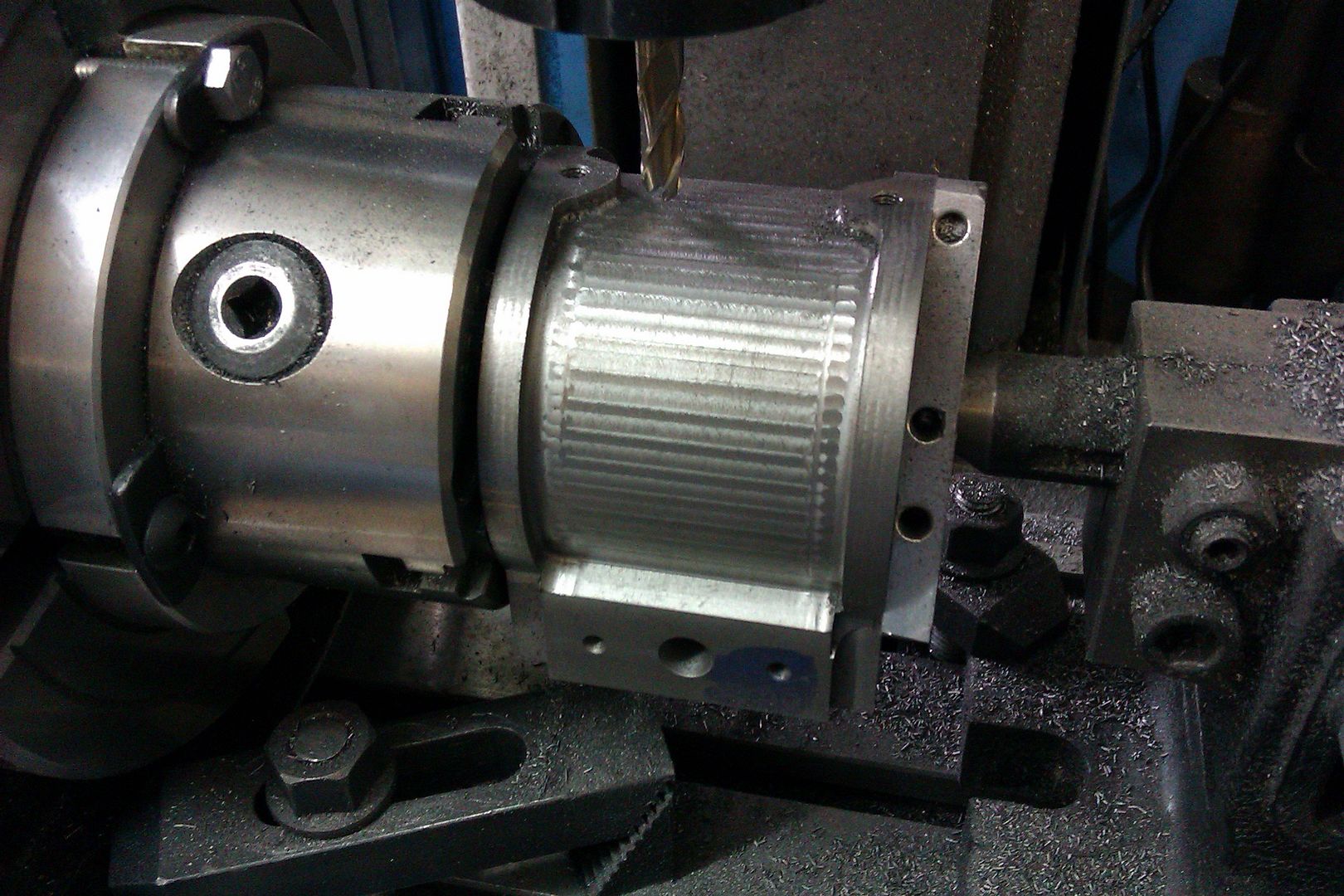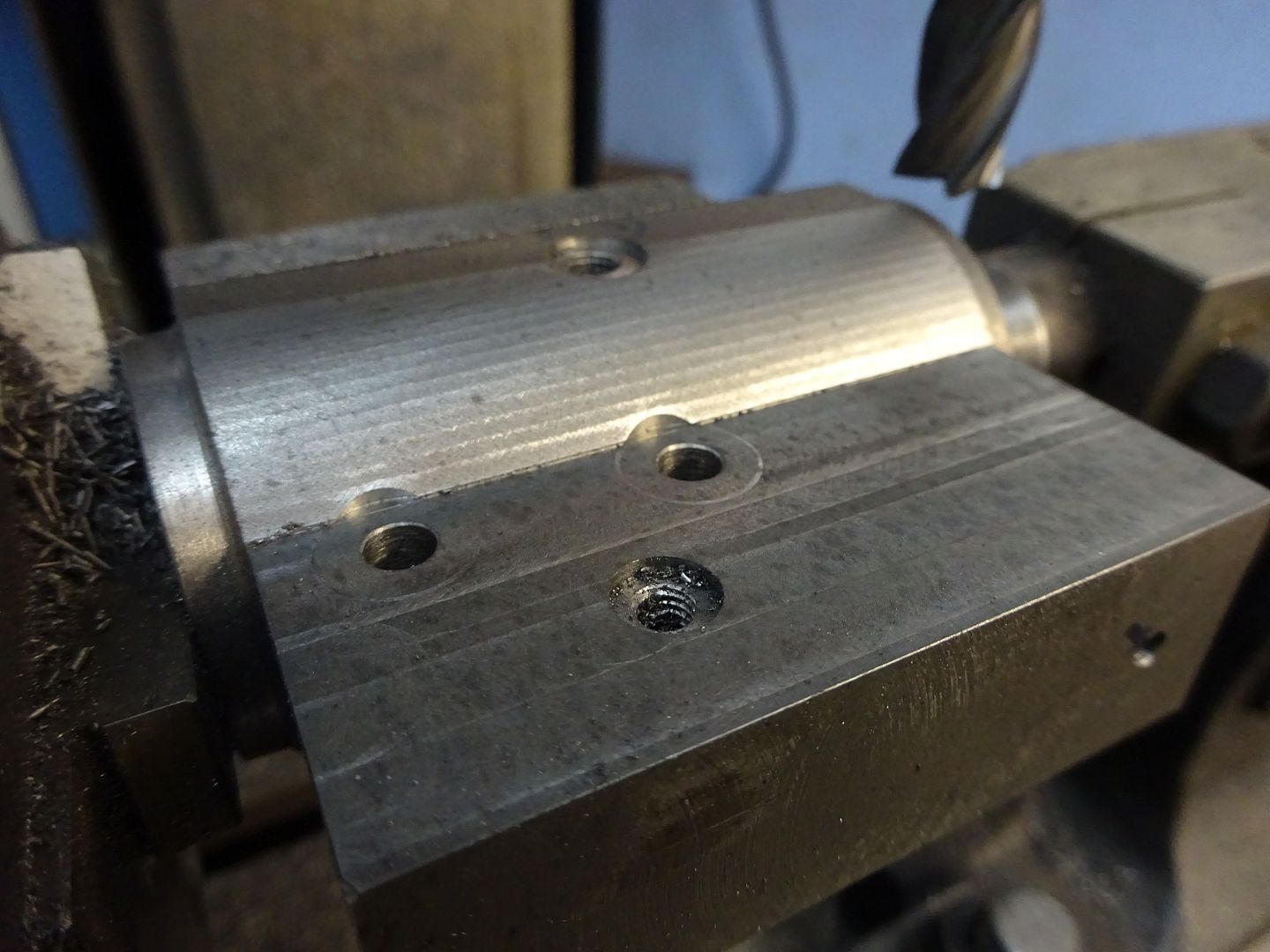You are using an out of date browser. It may not display this or other websites correctly.
You should upgrade or use an alternative browser.
You should upgrade or use an alternative browser.
Milling problem
- Thread starter Jmccrack
- Start date

Help Support Home Model Engine Machinist Forum:
This site may earn a commission from merchant affiliate
links, including eBay, Amazon, and others.
- Status
- Not open for further replies.
canadianhorsepower
Well-Known Member
- Joined
- Oct 22, 2011
- Messages
- 1,671
- Reaction score
- 324
is your table tram with your z axis??
It seems WAY of
It seems WAY of
- Joined
- Jul 16, 2007
- Messages
- 3,023
- Reaction score
- 1,098
Ok here's what's happening.
You set up your piece and find the center axis. Now you bring your end mill down and touch off to the material, remembering that end mills are ground with clearance toward the center so only the tips cut. Now you go down in Z to the required depth and make one cut all the way around. You find that the surface isn't flat, it is higher in the center. This is because the end mill is only cutting to the proper depth out at the tip of the flutes. Here's a better way to understand it. Take a piece of round stock and lay a straight edge on the surface, at right angles to the axis. The only place the straight edge touches is right at the high point of the piece. Now turn the straight edge parallel with the part axis. It touches all the way across. What this is showing you is that the end mill only cuts to depth out at the edges because when the flutes are turned 90 degrees they hang out over the radius of the piece. The only way to come close to cutting it flat is to use a small diameter cutter and make several passes around the stock. Even at that it won't be like a surface turned in a lathe.
gbritnell
You set up your piece and find the center axis. Now you bring your end mill down and touch off to the material, remembering that end mills are ground with clearance toward the center so only the tips cut. Now you go down in Z to the required depth and make one cut all the way around. You find that the surface isn't flat, it is higher in the center. This is because the end mill is only cutting to the proper depth out at the tip of the flutes. Here's a better way to understand it. Take a piece of round stock and lay a straight edge on the surface, at right angles to the axis. The only place the straight edge touches is right at the high point of the piece. Now turn the straight edge parallel with the part axis. It touches all the way across. What this is showing you is that the end mill only cuts to depth out at the edges because when the flutes are turned 90 degrees they hang out over the radius of the piece. The only way to come close to cutting it flat is to use a small diameter cutter and make several passes around the stock. Even at that it won't be like a surface turned in a lathe.
gbritnell
- Joined
- Jul 16, 2007
- Messages
- 3,023
- Reaction score
- 1,098
If you want to come close use a smaller cutter and make several passes then file it smooth once you're finished. Before you get ready to file it put some marker ink on the surface and then you will see where the high spots are and just file down until the marker disappears. If the surface needs to be dead flat and held to a dimension then this isn't the way to be doing it.
gbritnell
gbritnell
- Joined
- Jun 4, 2008
- Messages
- 3,289
- Reaction score
- 635
It is possible to buy a flat bottom endmill.
Engine maker
Well-Known Member
Use a 2 fluted end mill! The center of a 4 fluted end mill doesn't cut, and as your bringing the curve of the work piece up to the cutter the tips don't cut the center. That's why you can drill a hole with a 2 fluted end mill but not a 4 fluted one.
Last edited:
Just a note EM.
A few years ago your statement would have been correct, but nowadays you should find that most have one flute extended across centre to alleviate that problem.
I use mainly six fluted carbides, and they are all ground that way.
When they started to introduce three flute 'disposable' cutters, mainly for CNC machines, was when they started to grind most multi flutes with that extended cutting edge, so in theory, there is no such thing any more as a slot drill or end mill, they are now usually just classed as milling cutters and you order by the number of flutes and diameter, though you still may see two flute cutters described as slot drills.
John
A few years ago your statement would have been correct, but nowadays you should find that most have one flute extended across centre to alleviate that problem.
I use mainly six fluted carbides, and they are all ground that way.
When they started to introduce three flute 'disposable' cutters, mainly for CNC machines, was when they started to grind most multi flutes with that extended cutting edge, so in theory, there is no such thing any more as a slot drill or end mill, they are now usually just classed as milling cutters and you order by the number of flutes and diameter, though you still may see two flute cutters described as slot drills.
John
- Joined
- Dec 12, 2012
- Messages
- 2,220
- Reaction score
- 1,287
I agree with what has been said ,however a flat surface should always be achieved with an end mill if the lathe is trammed and the cutter ground correctly.The full area must be covered by the outside edge of the end mill
goldstar31
Well-Known Member
I certainly agree with John but my world is covered with old type cutters which seems to work OK.
The big problem( for me) is rounding the extreme tips of the cutters. I have yet to master how to do it on my radius thing on the Clarkson. Ah, well?
Regards
Norman
The big problem( for me) is rounding the extreme tips of the cutters. I have yet to master how to do it on my radius thing on the Clarkson. Ah, well?
Regards
Norman
Cogsy
Well-Known Member
a flat surface should always be achieved with an end mill if the lathe is trammed and the cutter ground correctly.The full area must be covered by the outside edge of the end mill
Not where the piece is curved such as this. Place an end mill straight down on a piece of round stock and you will see it is only touching on the ends of the flutes parallel with the stock. The flutes perpendicular to the stock are hanging in air. Now imagine taking a cut while rotating the piece and you would be cutting the edges but not the centre.
- Joined
- Dec 12, 2012
- Messages
- 2,220
- Reaction score
- 1,287
Thats correct cogsey but if the edge of the cutter passes over the centre
then that removes the raised area in the centre.Again a flat surface.As long as the endmill is slightly concave due to bottom clearance it will cut a flat surface
If the end mill is slightly convex IE a ball nosed mill then it wont
then that removes the raised area in the centre.Again a flat surface.As long as the endmill is slightly concave due to bottom clearance it will cut a flat surface
If the end mill is slightly convex IE a ball nosed mill then it wont
Its as George says. Even ctr cutting 2-3-4 flute cutters have the cutting flute at a slight angle, try plunge cutting into teh edge of some scrap so the centreline of the tool is on teh edge of teh work then look at the bottom of the cut it will be a shallow inverted V
I have made several cylinders and similar parts but I cut along the Y axis, rotate work and take another cut. Depending on the amount of rotation you will get a series of facets, these can easily be blended with a file or in the case of a cylinder that will be lagged its not seen on the finished item.
1 degree increments on 40mm square steel, hardly visible

4deg as they were going to be covered, this was a hand ground corner radius cutter so rubbed a bit on te bottom

4 deg I think

Same part after a quick but of file work

I have made several cylinders and similar parts but I cut along the Y axis, rotate work and take another cut. Depending on the amount of rotation you will get a series of facets, these can easily be blended with a file or in the case of a cylinder that will be lagged its not seen on the finished item.
1 degree increments on 40mm square steel, hardly visible

4deg as they were going to be covered, this was a hand ground corner radius cutter so rubbed a bit on te bottom

4 deg I think

Same part after a quick but of file work

kettrinboy
New Member
- Joined
- Dec 11, 2015
- Messages
- 4
- Reaction score
- 0
To avoid these ridges with a small dia cutter why not use a flycutter adjusted to cover the whole width of the part , that's what I would do if an even surface was needed.
- Status
- Not open for further replies.
Similar threads
- Replies
- 12
- Views
- 1K







